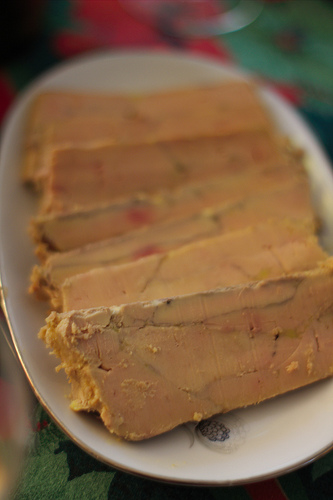Foie gras is a luxurious delicacy at one destination and an illegal product at another.
- ‘Foie gras’, a French term that can be translated into English as ‘fat liver’, is a food made of an enlarged bird liver, that is consumed as a delicacy in various parts of the world.
- Ducks, often the hybrid Mulard species that are a cross between a Pekin and a Muscovy duck, are most commonly used to produce foie gras, totalling just over 98% of French production in 2014, while the remainder are usually geese.
- Ducks and geese that are used for foie gras are prepared by force feeding two to three times a day using a small pipe inserted into their throat, a process known as ‘gavage’, which takes a total time of around two to three seconds for each bird.
- Foie gras is served both hot and cold, generally cooked by roasting, grilling and pan-searing, or slow cooking methods as in a terrine, and is typically served with vegetables or other meats.
- Many areas in the world, including a number of European countries like Germany, Denmark and Norway; India; Australia; and some parts of the United States, have marked foie gras as an illegal product to produce, as force feeding the birds may be considered inhumane or cruel, and some of these countries has also banned the import and consumption of the product.
Foie Gras
Image courtesy of Jeremy Couture/Flickr
- Force feeding of birds for foie gras generally occurs after 63 to 90 days from hatching, and this method of feeding lasts for around 12 to 25 days, when the liver is roughly six to ten times the normal size, after which they are slaughtered.
- France is one of the greatest advocators of foie gras, stating it is a “cultural and gastronomical heritage” of the country, and have thus gone to lengths to protect the industry.
- From around 2500 BC Ancient Egyptians force fed birds to fatten them, similar to the foie gras production process, and the practice eventually spread across Europe, while the earliest known mention of the consumption of fat bird livers is during Roman times.
- France is the largest producer of foie gras in the world, with a total of 19,300 tonnes (21,275 tons) in 2014, or 72% of the total world production, of roughly 26,600 tonnes (29,321 tons).
- Foie gras is very high in fat, cholesterol, vitamin A, vitamin B12, iron and selenium, and has a buttery feel in the mouth, and rich flavour.
Bibliography:
Foie Gras, 2015, Wikipedia, https://en.wikipedia.org/wiki/Foie_gras
Foie Gras: Cruelty to Ducks and Geese, n.d, PETA, http://www.peta.org/issues/animals-used-for-food/factory-farming/ducks-geese/foie-gras/
López-Al J, The Physiology of Foie: Why Foie Gras is Not Unethical, n.d, Serious Eats, http://www.seriouseats.com/2010/1 2/the-physiology-of-foie-why-foie-gras-is-not-u.html







